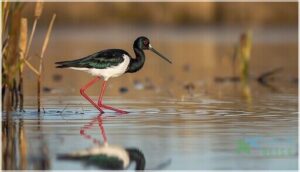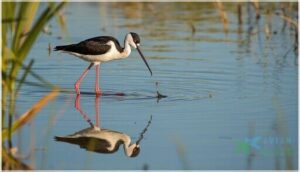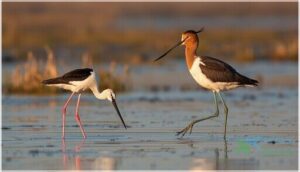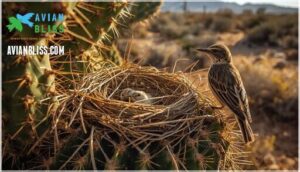This site is supported by our readers. We may earn a commission, at no cost to you, if you purchase through links.
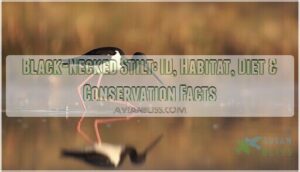
This isn’t just biological flair for show; those legs open shallow waters other waders can’t reach, giving stilts access to a buffet their competitors miss entirely. You’ll find these striking birds scattered across wetlands from California’s salt ponds to South America’s coastal flats, always where water meets opportunity.
Despite thriving in landscapes humans have altered—sewage ponds, drainage ditches, retention basins—the black-necked stilt faces real threats from habitat destruction and pollution. Understanding what makes this species tick reveals not just striking adaptation, but urgent conservation needs you can’t ignore.
Table Of Contents
- Key Takeaways
- Black-necked Stilt Identification
- Natural Habitat and Distribution
- Feeding Habits and Diet
- Breeding and Nesting Behavior
- Conservation Status and Threats
- Frequently Asked Questions (FAQs)
- Are Black-necked Stilts rare?
- What is the difference between black-necked and black winged stilts?
- What bird is similar to the Black-necked Stilt?
- Can Black-necked Stilts fly?
- How do Black-necked Stilts interact with other shorebirds?
- How do Black-necked Stilts compare to Wilsons phalaropes?
- What are common predators of Black-necked Stilts?
- How do Black-necked Stilts communicate with each other?
- How long do black-necked stilts typically live?
- What sounds or calls do they make?
- Conclusion
Key Takeaways
- Black-necked stilts exploit ecological niches competitors can’t access through extreme leg proportions that reach 60% of body length, enabling them to wade depths up to 30 cm where other shorebirds physically can’t follow.
- The species demonstrates remarkable adaptability by thriving in human-modified environments like sewage ponds and irrigation channels, with up to 80% of Arizona’s breeding populations now occupying artificial wetlands rather than pristine habitat.
- While North American populations show healthy growth at 1.7% annually, the endangered Hawaiian subspecies hovers critically at just 1,500-1,800 individuals, requiring aggressive predator control and habitat management to prevent extinction.
- Pollution poses a severe threat beyond habitat loss, with 80% of Texas stilts exceeding lead contamination thresholds and selenium causing embryo deformities—toxic exposure that compounds as wetland loss forces birds into contaminated industrial sites.
Black-necked Stilt Identification
You can spot a Black-necked Stilt from a hundred yards away if you know what to look for. These shorebirds don’t blend in—they stand out with features so distinctive that even first-time birders can nail the ID.
Here’s what sets them apart from everything else wading through the shallows.
Distinctive Black and White Plumage
You’ll instantly recognize the Black-necked Stilt by its striking color pattern—glossy black upperparts sharply contrasted against pure white underparts. Males display jet-black plumage with greenish gloss during breeding season, while females show brownish-black tones. This visual camouflage works brilliantly in wetland reflections, and the distinctive white eye spot above each crimson iris acts as a key species recognition marker. Breeding occurs from mid-April to mid-August.
- Upperparts feature glossy black on males, brownish-black on females
- White forehead, underparts, and distinctive spot above each eye
- Juveniles show buff-edged feathers with less intense coloration
- Black cap extends continuously from hindneck to crown
- Solid black wings above and below emphasize sharp plumage patterns
Exceptionally Long, Pink Legs
Beyond that stunning plumage, you’ll notice the Black-necked Stilt’s most striking feature—legs that seem almost impossibly long. These pink-to-coral appendages rank second only to flamingos in proportional leg length among all birds, with adult males sporting legs up to 18 cm. This avian morphology isn’t just for show—it’s evolutionary brilliance.
| Feature | Measurement | Functional Advantage |
|---|---|---|
| Leg Length | Up to 18 cm (50% of height) | Wade in 30 cm depths |
| Pigmentation | Pale pink to coral-red | Intensifies during breeding |
| Toe Webbing | Partially webbed | Enhanced stability |
| Tarsometatarsus | Highly elongated | Optimized energy use |
The leg pigmentation varies with diet—carotenoid-rich prey produces deeper coral tones, especially visible April through August. Females show subtler salmon-pink coloration. Compared to the American Avocet’s grayish legs, stilts display distinctly vibrant hues.
This comparative anatomy reveals functional adaptations refined over 1.5 million years. Stilts primarily use visual foraging to find food in shallow waters. Your stilt’s elongated limbs access aquatic prey at mid-depths where shorter-legged shorebirds can’t reach, exploiting niches competitors simply can’t touch. The slender geometry reduces movement resistance, letting these birds sprint across mud flats with remarkable efficiency. Watch them perform the “popcorn display”—hopping laterally with fully extended legs—and you’ll witness evolutionary context in action.
Slender, Needle-like Black Bill
Those striking legs lead straight to another defining feature—a bill so thin and precise it looks like nature’s own surgical instrument. This slender, needle-like black bill measures 6.5–7.5 cm in adults, accounting for roughly 18–22% of head-body length. Bill morphology reveals how stilts master foraging techniques:
- Surface pecking captures prey as small as 1–3 millimeters
- Sideways “scything” motion detects hidden invertebrates
- Underwater plunging reaches belly-deep prey zones
- Rapid probing averages 34–52 pecks per minute
Males sometimes show glossier black tones during breeding, while females display slightly shorter bills—usually 2–4% less than males. This avian morphology allows for high prey capture success rates up to 72% in shallow wetlands. Unlike the American Avocet’s upturned design, your Black-necked Stilt’s straight bill targets surface and mid-water invertebrates with surgical precision.
Geographic population variation shows Pacific Coast individuals averaging 7.2 cm versus Gulf populations at 6.9 cm. This species comparison highlights ecological function—the bill’s straight design minimizes resistance during repeated probing, letting stilts exploit niches competitors can’t access. For bird identification guide purposes, that consistently black, needle-straight profile remains diagnostic year-round.
Size, Weight, and Wingspan Measurements
Beyond that precision bill, you’ll find body length variations spanning 14–17 inches, with males reaching the upper range. Weight factors hover around 5.3–6.2 ounces, though breeding adults can tip 7.9 ounces. Wingspan measurements stretch 28–30 inches across.
Most striking? Leg proportions claim over 60% of total length—up to 10 inches of vivid pink scaffolding that makes size comparisons with other waders look almost comical.
The stilt’s legs claim over 60% of its body length—up to 10 inches of vivid pink scaffolding that dwarfs other waders
Comparison to Similar Shorebirds
When comparing Black-necked Stilts to similar shorebirds like American Avocets, you’ll notice key differences in bird morphology and size comparison. Avocets stand taller and weigh nearly double—315 grams versus your stilt’s 160 grams. Their upturned bills contrast with the stilt’s straight needle-like structure, affecting species coexistence through distinct foraging niches in wetland ecology where shorebird migration patterns overlap, demonstrating how regional bird variations support avian sociality.
Natural Habitat and Distribution
Black-necked Stilts aren’t picky about sticking to untouched wilderness—they’ve carved out a living across a surprisingly vast range. You’ll find them wading through wetlands from the coastal edges of North America down to the heart of South America, and even on remote Hawaiian shores.
Let’s break down where these long-legged wanderers call home and how they’ve adapted to both wild and human-altered landscapes.
Preferred Wetlands and Shallow Waters
You’ll find Black-necked Stilts where shallow water meets open sky—wetlands that offer easy access to food and nesting sites. They prefer water depths up to 5.9 inches, where their long legs give them an edge.
Look for them in marshes, mudflats, salt ponds, and even rice fields. These shorebirds thrive in aquatic ecosystems with minimal vegetation, where they can wade freely through their habitat.
Geographic Range in The Americas and Hawaii
From coastal California to the Galápagos Islands, you’ll encounter Black-necked Stilts across a vast range spanning North and South America. Migration patterns move northern populations southward between July and September, with spring returns from March to May.
The endangered Hawaiian subspecies (ae’o) inhabits fewer than 25 wetland complexes. Regional distribution reaches from Washington state through Central America to Brazil, with habitat expansion into artificial sites increasing their conservation geography footprint.
Adaptation to Human-modified Environments
You’ll find Black-necked Stilts thriving where nature meets human engineering—salt ponds, sewage treatment facilities, and irrigation channels now serve as essential breeding grounds. Up to 80% of Arizona’s breeding evidence occurs in these human-modified spaces, demonstrating impressive environmental adaptations:
- Urban Habitat Use: Drainage ditches and retention basins support nesting populations
- Artificial Nesting Sites: Salt evaporation ponds accommodate breeding colonies
- Wetland Restoration: Managed waters provide foraging opportunities
- Human Impact Mitigation: Conservation efforts balance development with habitat preservation
Sensitivity to Habitat Changes
You’re witnessing a species on the edge—Black-necked Stilts face mounting pressure as wetlands vanish beneath their feet. Drought, climate shifts, and wetland degradation trigger rapid habitat loss, forcing these shorebirds to relocate up to 4.5 km in search of suitable breeding grounds. Without habitat preservation and strengthened conservation efforts, habitat fragmentation will continue undermining ecosystem resilience and species adaptation.
| Threat Type | Impact on Population | Conservation Response |
|---|---|---|
| Wetland Loss | 33 waterbird species declining | Habitat preservation programs |
| Water Management | Forced relocation 4.5 km | Hydroperiod monitoring |
| Seasonal Drying | Growth stagnates below 50% cover | Wetland restoration projects |
| Climate Shifts | Breeding phenology altered | Shorebird conservation strategies |
| Habitat Fragmentation | Breeding habitat restricted 5/6 months | Protected corridor development |
Feeding Habits and Diet
You’ll find black-necked stilts wading through shallow waters with a purpose—they’re hunting for their next meal. These birds are carnivores at heart, feeding primarily on the small creatures that thrive in wetland environments.
Let’s break down what fuels these elegant shorebirds and how they catch their prey.
Primary Food Sources: Insects and Crustaceans
You’ll find that insects and crustaceans dominate the Black-necked Stilt diet, comprising over 80% of their aquatic food intake. Insect prey—particularly beetles, flies, and mosquito larvae—account for roughly 60% in freshwater habitats, while crustacean diet components like brine shrimp and crayfish make up to 50% at coastal sites.
This feeding behavior reflects specialized prey capture techniques and foraging strategies shaped by habitat salinity and seasonal availability.
Foraging Behavior in Shallow Water
You’ll observe Black-necked Stilts employing diverse foraging techniques as they wade through shallow water on those impossibly long legs. Their prey detection combines sharp vision with tactile bill sweeping—side-to-side motions that locate invertebrates just below the surface.
Feeding strategies adapt to water depth and habitat selection: they’ll peck stationary prey, plunge their heads underwater, or even herd small fish into shallows. These shorebird characteristics reveal feeding behavior shaped by environmental conditions and prey availability.
Occasional Consumption of Fish and Plant Matter
While aquatic invertebrates dominate their meals, you’ll occasionally spot Black-necked Stilts consuming small fish and plant seeds—dietary flexibility that helps them survive when insects run scarce. Fish intake patterns remain minimal, documented at just 3.2% by weight in stomach analyses, with gape size limiting what they can swallow.
Seasonal food shifts bring increased plant matter consumption during colder months, particularly widgeon grass and bulrush seeds in Utah marshes, where plant material reached 17% of diet samples—a foraging adaptation that showcases this shorebird’s opportunistic nature.
Bill Techniques for Capturing Prey
You’ll witness three primary foraging strategies when observing Black-necked Stilt feeding behavior. Visual foraging dominates daylight hunting—stilts peck at surface invertebrates with surgical precision, accounting for over 50% of attempts.
Tactile feeding emerges during low-visibility conditions, with rapid side-to-side bill sweeps through mud at 2–4 sweeps per second.
Skimming techniques capture mosquito larvae and insects, yielding up to 12 prey per minute in productive shorebird habitats.
Breeding and Nesting Behavior
Black-necked Stilts don’t waste time when breeding season arrives—they’re all about action and adaptability. You’ll find them nesting in loose colonies, often alongside avocets, where both parents share the workload from construction to chick-rearing.
Let’s break down how these striking shorebirds handle their most critical season.
Mating and Pair Bonding
Black-necked Stilt courtship displays are fascinating. Males perform sexual preening 20 to 30 cm from females, while both sexes engage in synchronized bill dipping culminating in mate selection. These elegant shorebirds form socially monogamous pair bonds lasting one breeding season, collaborating on territory defense and reproductive success.
Key Blacknecked Stilt Reproduction behaviors include:
- Intense territorial behavior with aerial combat between competing males
- Elaborate courtship displays featuring synchronized preening and bill crossing
- Monogamous pair bonding that dissolves after breeding season ends
- Cooperative partnership throughout bird life cycle and parental care duties
Nest Site Selection and Construction
Strategic nest placement begins within a kilometer of reliable feeding grounds, where you’ll find pairs scraping shallow depressions roughly 5 inches in diameter. Colony formation usually clusters 6 to 10 nests with 20-meter spacing, though habitat modification occasionally brings nests as close as 7 feet apart.
Blacknecked Stilt nesting habits favor sparse vegetation on dikes or islands, where both sexes collaborate on nest architecture using local shells, grasses, and pebbles.
Egg Incubation and Parental Care
You’ll witness extraordinary dedication once those speckled olive eggs arrive—incubation periods span 22 to 26 days with both parents sharing duties:
- Females dominate nighttime shifts while males patrol during daylight
- Adults make 100+ water trips daily, wetting belly feathers to cool eggs
- Incubation begins after the next-to-last egg drops
- Hawaiian populations recruit helpers for cooperative nesting
Blacknecked Stilt nesting habits exemplify shared parental roles, ensuring brood survival through coordinated care.
Chick Development and Predator Deterrence
Within 24 hours of hatching, you’ll see Young Blacknecked Stilt chicks leave their nests—no direct feeding from parents required. Chick Mortality peaks in week one, driving Nesting Strategies like colony defense through dive-bombing and mobbing. Tall vegetation cuts predator avoidance risks by 65%.
After Incubation, fledging success reaches 40% at 27–31 days, with parents maintaining aggressive perimeter patrols throughout development.
Conservation Status and Threats
The Black-necked Stilt stands at a crossroads—its overall numbers are climbing, yet hidden fractures threaten specific populations. You’ll find a species resilient enough to colonize sewage ponds but vulnerable to the very forces reshaping its world.
Here’s what shapes its fate across wetlands from California to the Galápagos.
Global and Regional Population Trends
You’re looking at a conservation success story unfolding across the Americas. The Black-necked Stilt’s global population stands strong at roughly 900,000 individuals, with numbers climbing steadily. Here’s what’s driving these regional trends:
- North American populations gained almost 1.7% annually from 1966 to 2015
- Texas populations surged 7.3% per year between 1980 and 2007
- Habitat expansion into Canada shows the species adapting northward
- Climate impact and conservation efforts continue shaping population dynamics across wetland corridors
Endangered Hawaiian Subspecies
When you encounter the Hawaiian subspecies, you’re witnessing one of conservation’s frontline battles. This federally endangered population hovers between 1,500 and 1,800 individuals across the islands—a stark contrast to the mainland’s healthy numbers.
Recovery planning targets 2,000 birds for downlisting, while habitat restoration, predator control, and conservation planning tackle threats from feral cats, mongoose, and invasive species disrupting ecological balance.
Impacts of Habitat Loss and Pollution
You’ll find black-necked stilts caught in a perfect storm of habitat destruction and toxic exposure. North American wetland degradation has pushed western breeding populations below historic levels, while pollution effects compound the crisis:
- 80% of Texas stilts exceed lead contamination thresholds
- Selenium buildup causes embryo deformities in California
- DDT breakdown products contaminate 90% of tested eggs
Climate change accelerates wetland drying, forcing these birds into contaminated industrial sites where survival becomes a daily gamble.
Conservation Efforts and Management Strategies
Recovery from contamination starts with aggressive wetland restoration and species protection across five Hawaiian islands. Conservation planning prioritizes core habitats, with 85% requiring active habitat management over 10 years to maintain populations above 2,000 birds. Black-necked Stilt conservation depends on predator control, which reduces nest losses by 50%, along with the creation of artificial mitigation wetlands and collaborative shorebird conservation efforts involving federal agencies and private landowners.
| Conservation Strategy | Implementation Scale | Measured Impact |
|---|---|---|
| Predator exclosures & trapping | Core breeding wetlands | 50% nest loss reduction |
| Artificial wetland creation | 130+ hectares minimum | Increased breeding success |
| Water management protocols | 85% of supporting sites | Population stability maintenance |
Frequently Asked Questions (FAQs)
Are Black-necked Stilts rare?
Black-necked Stilts aren’t rare globally—their population stability reflects local abundance across wetlands. However, subspecies variation matters: Hawaii’s endangered population faces conservation dependence, highlighting species vulnerability factors despite overall conservation status remaining secure.
What is the difference between black-necked and black winged stilts?
When two birds mirror each other across continents, you’ll spot the truth in their legs—pink versus orange-red defines black-necked from black-winged stilts, along with subtle plumage patterns and bill morphology differences.
What bird is similar to the Black-necked Stilt?
You’ll spot the American Avocet alongside Black-necked Stilts in similar wetland habitats.
This distinctive shorebird shares their wading lifestyle but sports an upturned bill—perfect for sweeping through shallow waters hunting aquatic invertebrates.
Can Black-necked Stilts fly?
Like feathered arrows released into open sky, you’ll find these shorebirds are outstanding fliers. They reach speeds up to 40 mph during predator evasion, with pointed wings providing aerodynamic efficiency for swift, buoyant flight patterns across migration routes.
How do Black-necked Stilts interact with other shorebirds?
You’ll see territorial behaviors during breeding season, when stilts challenge rivals and defend nests aggressively.
They share habitats with other shorebirds like avocets, competing for food yet cooperating through colony behavior and collective predator defense.
How do Black-necked Stilts compare to Wilsons phalaropes?
Wilson’s Phalaropes are smaller shorebirds with unique spinning foraging techniques and sex-role reversal breeding behavior.
Stilts have longer pink legs, distinct black-and-white plumage, and probe-feeding methods, with overlapping migration patterns enabling species coexistence.
What are common predators of Black-necked Stilts?
You’ll find raccoons, skunks, foxes, and coyotes targeting nests—mammalian predators responsible for over 70% of losses. Avian threats include gulls and raptors hunting eggs and chicks.
Nest defense strategies help Black-necked Stilt populations counter these mortality rates through wildlife conservation.
How do Black-necked Stilts communicate with each other?
During breeding season, these shorebirds dedicate 32% of active time to visual displays.
Black-necked Stilts communicate through sharp alarm calls and territorial postures, maintaining social cohesion with contact vocalizations and elaborate courtship behaviors, including bill-crossing rituals.
How long do black-necked stilts typically live?
You’ll find black-necked stilts living around 19 to 20 years in the wild, though lifespan factors like predation and habitat quality influence survival strategies.
Longevity studies through avian biology research reveal maximum age records reaching 16 years documented.
What sounds or calls do they make?
You’ll hear sharp, high-pitched yaps and keek sounds from these birds—alarm calls that pierce the air when threats approach.
Their vocal variations serve multiple functions: territory defense, mate communication, and predator warnings during breeding season.
Conclusion
Picture a restoration pond in California’s Central Valley: where biologists once saw only muddy runoff, black-necked stilts now patrol the shallows, their pink legs slicing through reflections. That transformation isn’t accidental—it’s engineered resilience meeting evolutionary brilliance.
Your attention to wetland quality directly influences whether this species continues adapting or starts disappearing. Every marsh you protect, every pollutant you prevent from reaching shallow waters, tips the balance toward survival for birds that refuse to blend into the background.
- https://www.texassaltwaterfishingmagazine.com/fishing/black-necked-stilt
- https://georgiabiodiversity.org/portal/profile?group=birds&es_id=20477
- https://earthlife.net/black-necked-stilts/
- https://txtbba.tamu.edu/species-accounts/black-necked-stilt/
- https://fieldguide.mt.gov/speciesDetail.aspx?elcode=ABNND01010

